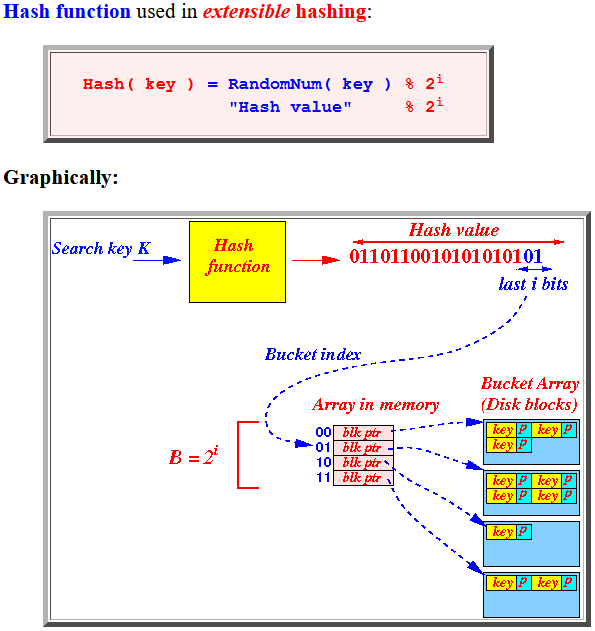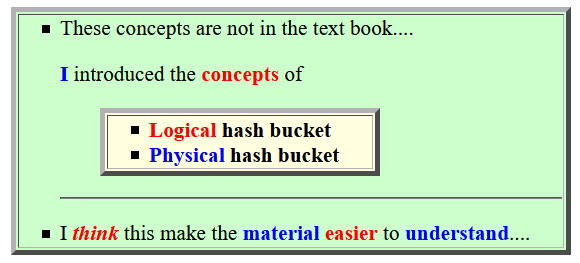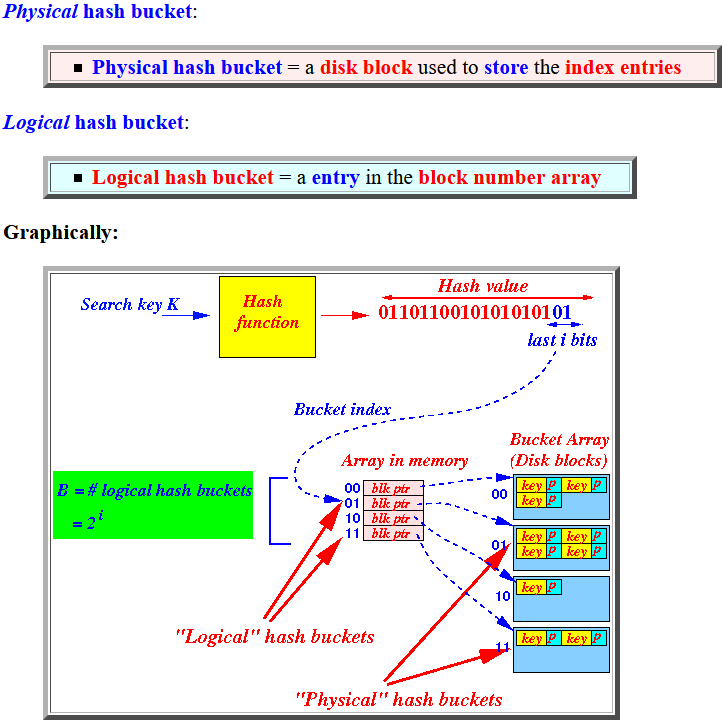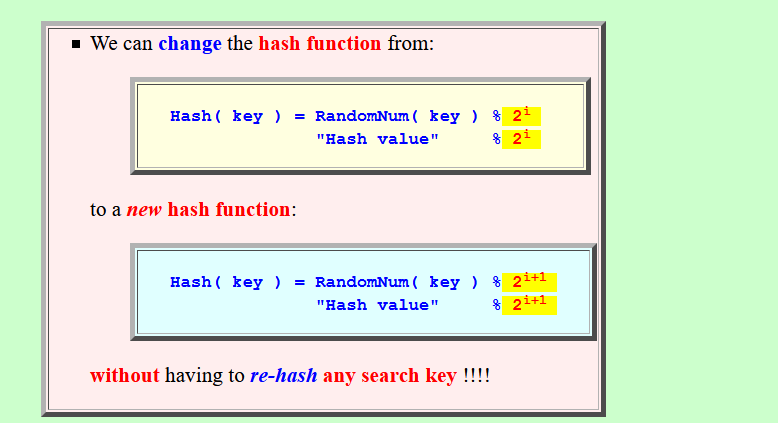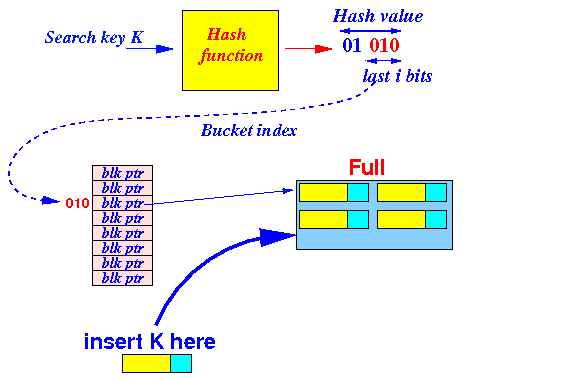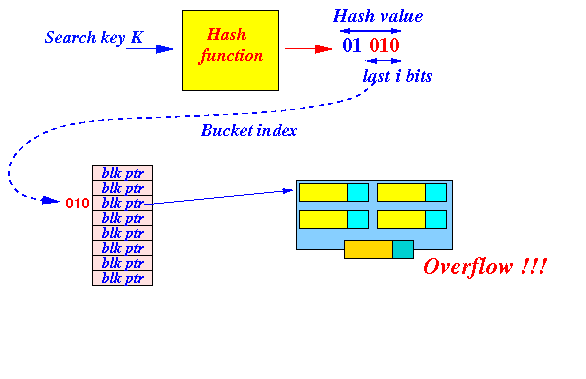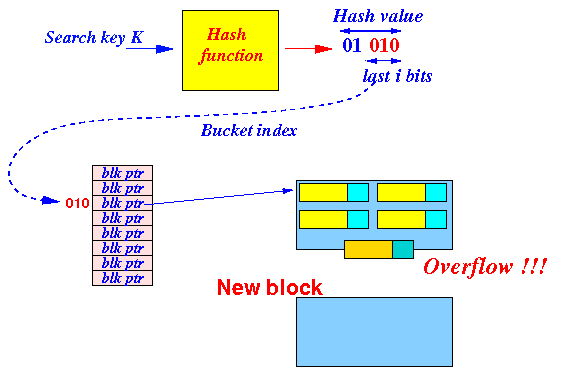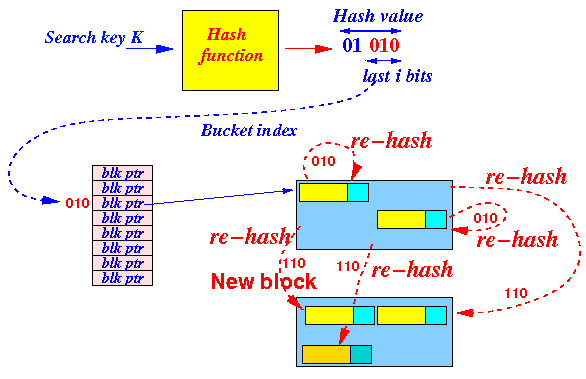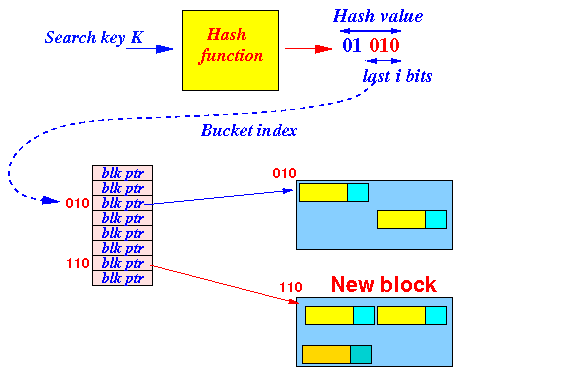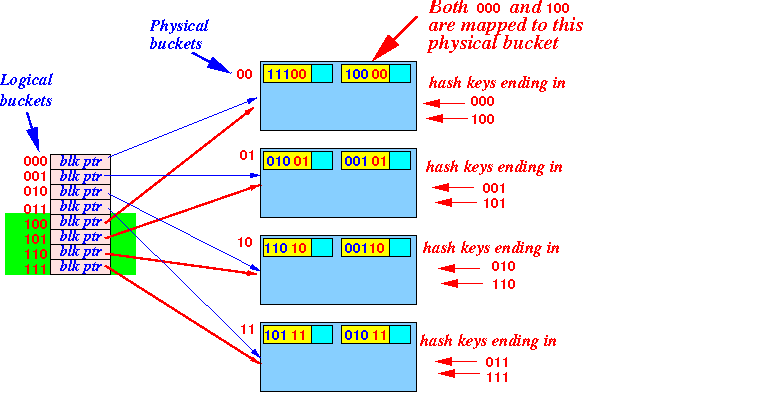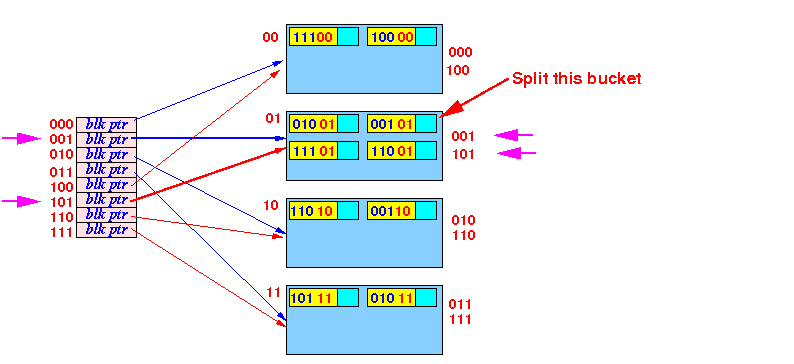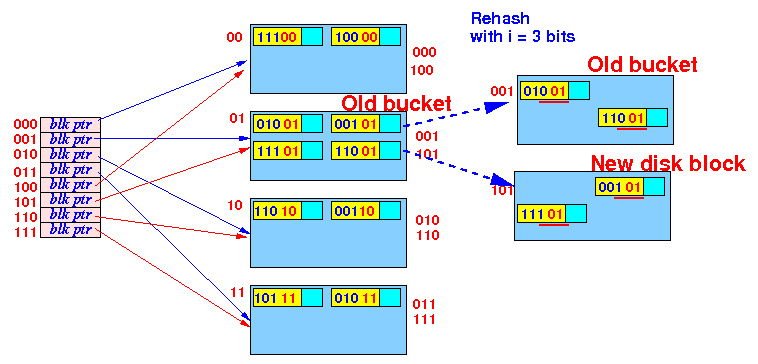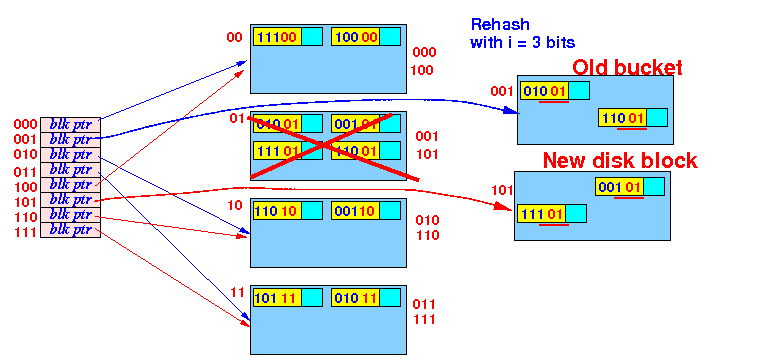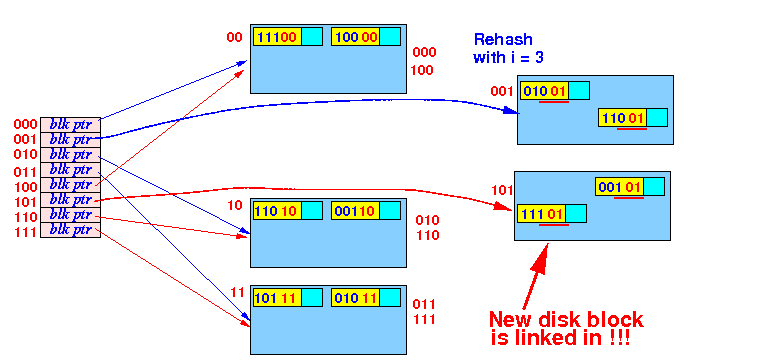Slideshow:
- Hash function used
in traditional hash techniques:
Hash( key ) = RandomNum( key ) % B = "Hash value" % Bwhere:
- B =
number of
hash buckets
B is usually a prime number (so that Hash(key) is uniformly distributed)
- B is fixed !!!
- B =
number of
hash buckets
- Hash function used
in extensible hashing:
Hash( key ) = RandomNum( key ) % 2i "Hash value" % 2iGraphically:
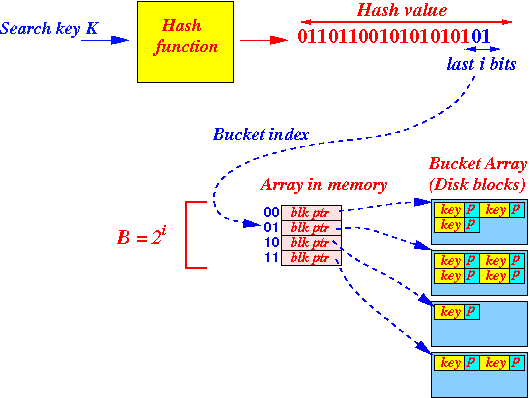
In other words:
Hash( key ) = last i-bits of the Hash-value
- Number of
hash buckets
is Extensible hashing:
- Number of
hash bucket B =
2i
- i can change !!!
- Number of
hash bucket B =
2i
- Comment:
- These concepts are not in the text book....
I introduced the concepts of
- Logical hash bucket
- Physical hash bucket
- I think this make the material easier to understand....
- These concepts are not in the text book....
- Physical hash bucket:
- Physical hash bucket = a disk block used to store the index entries
- Logical hash bucket:
- Logical hash bucket = a entry in the block number array
Graphically:

- In "normal" hashing:
- The number of
logical hash bucket
is equal to the
number of
physical hash bucket
and
- Every logical hash bucket is mapped to a different physical hash bucket
Graphically:

- The number of
logical hash bucket
is equal to the
number of
physical hash bucket
and
- In Extensible hashing:
- The number of
logical hash bucket
is
≥ the
number of
physical hash bucket
and
- Every logical hash bucket
is mapped to
a physical hash bucket
- Multiple logical hash buckets can be mapped to the same physical hash bucket !!!
Graphically:

- The number of
logical hash bucket
is
≥ the
number of
physical hash bucket
and
- Important property
of Extensive hashing:
- In Extensive hashing,
we can double the
size of the
logical hash table
without having
to re-hash
any keys !!!
In other words:
- In Extensive hashing, we can double the range of the hash function without having to re-hash any keys !!!
- Meaning:
- We can change the
hash function from:
Hash( key ) = RandomNum( key ) % 2i "Hash value" % 2i
to a new hash function:
Hash( key ) = RandomNum( key ) % 2i+1 "Hash value" % 2i+1
without having to re-hash any search key !!!!
- We can change the
hash function from:
- In Extensive hashing,
we can double the
size of the
logical hash table
without having
to re-hash
any keys !!!
- Example:
- Consider the
following example using
extensive hashing
where the hash function uses the
last 2 bits of the
hash value:
Hash( K ) = RandomNum( K ) % 4Graphically:
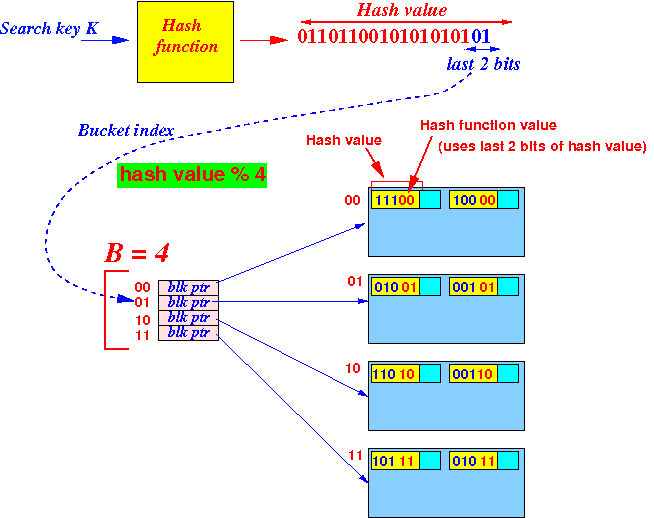
Notice that:
- Hash values that ends in 000 and 100 are stored in physical bucket 00
- Hash values that ends in 001 and 101 are stored in physical bucket 01
- Hash values that ends in 010 and 110 are stored in physical bucket 10
- Hash values that
ends in
011
and 111
are stored in
physical bucket 11
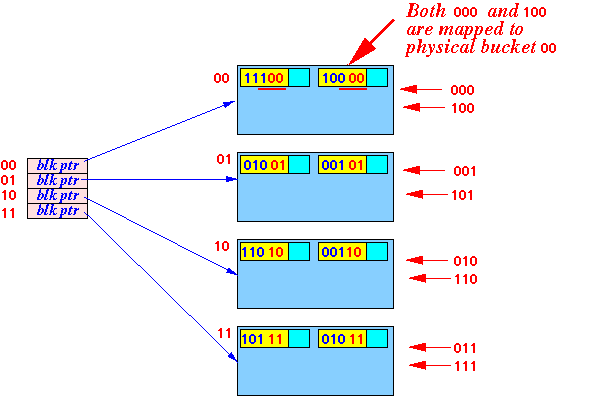
- Suppose we
double the
size of the
logical hash table by
using a different hash function:
Hash( K ) = RandomNum( K ) % 8Graphically:

- We can change the
hash function
(using B = 8)
without
having to
re-hash the
data records by
mapping the
new index buckets
as follows:
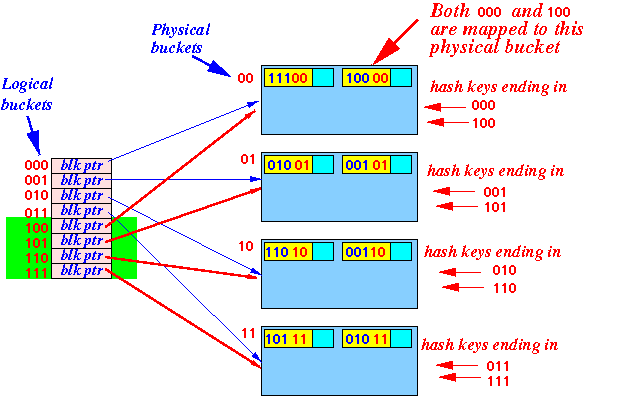
Notice that:
- Hash values that ends in 000 and 100 are directed to physical bucket 00
- Hash values that ends in 001 and 101 are directed to physical bucket 01
- Hash values that ends in 010 and 110 are directed to physical bucket 10
- Hash values that ends in 011 and 111 are directed to physical bucket 11
- Consider the
following example using
extensive hashing
where the hash function uses the
last 2 bits of the
hash value:
- Important observation:
- We can
locate
all the index records using
the
new hash function:
Hash( K ) = RandomNum( K ) % 8Example:
- Before we
increase the
logical hash table, we
use the last 2 bits in
the hash value to
find the logical hash bucket:
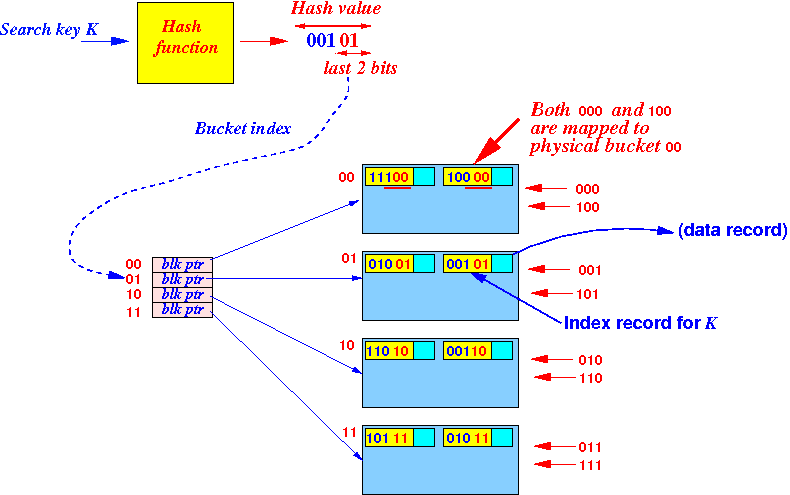
The last 3 bits that ends in 00 can be 000 or 100
The last 3 bits that ends in 01 can be 001 or 101
The last 3 bits that ends in 10 can be 010 or 110
The last 3 bits that ends in 11 can be 011 or 111
- We construct the
appropriate mapping to:
- 000 and 100 to the block that store hash key values ending in 00
- 001 and 101 to the block that store hash key values ending in 01
- 010 and 110 to the block that store hash key values ending in 10
- 011 and 111 to the block that store hash key values ending in 11
- We construct the
appropriate mapping to:
- After we
increase the
logical hash table, we
(must)
use the last 3 bits in
the hash value to
find the logical hash bucket:

The index record for every search key can still be found using the new ("larger") hash function !!
- Before we
increase the
logical hash table, we
use the last 2 bits in
the hash value to
find the logical hash bucket:
- We can
locate
all the index records using
the
new hash function:
- Conclusion:
- We can change the
hash function:
Hash( key ) = RandomNum( key ) % 2i "Hash value" % 2ito:
Hash( key ) = RandomNum( key ) % 2i+1 "Hash value" % 2i+1 (New Hash function will use a new B that is 2 × the old B)by:
- Double the
size of the
logical bucket buckets
- Map the
new
logical bucket buckets
as follows:
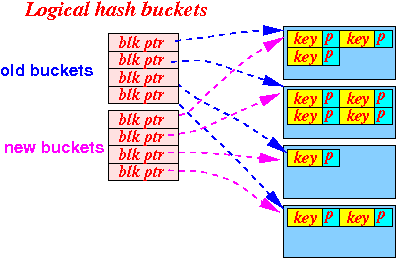
- Double the
size of the
logical bucket buckets
- We can change the
hash function:
- How to handle
overflow in
Extensive Hashing:
- When we
want to insert a
new search key K into
a full physical hash bucket:
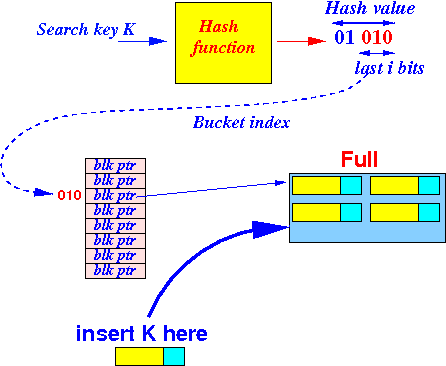
We will get an overflow condition:
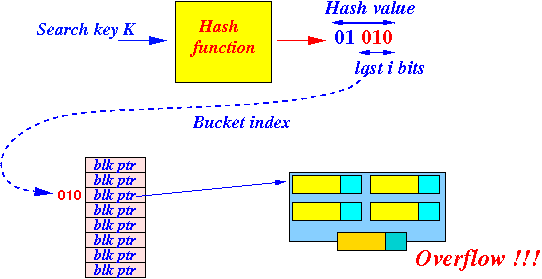
- To fix the
overflow condition,
we allocate
a new disk block (= physical bucket):
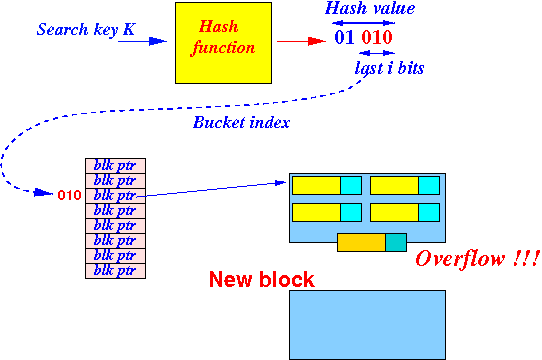
And re-hash (only) the keys in the overflow block (using one more bit):
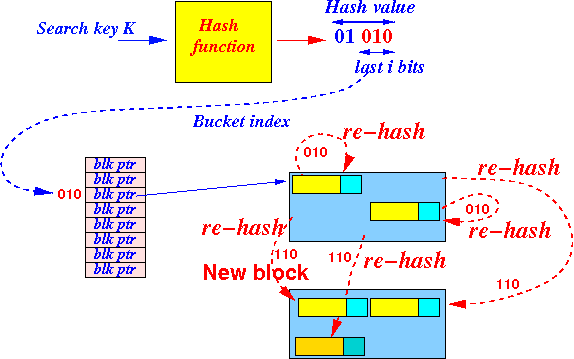
We still need to "link" the new hash bucket to the logical hash table.....
- When we
want to insert a
new search key K into
a full physical hash bucket:
- Important reminder:
- In Extensive Hahsing,
it is possible that
multiple logical hash buckets
are mapped into
the same physical hash bucket
Example:
- Logical buckets 000 and 100 are mapped to the physical bucket 00
- Logical buckets 001 and 101 are mapped to the physical bucket 01
- Logical buckets 010 and 110 are mapped to the physical bucket 10
- Logical buckets 011 and 111 are mapped to the physical bucket 11

- In Extensive Hahsing,
it is possible that
multiple logical hash buckets
are mapped into
the same physical hash bucket
- Very important property of
Extensible Hashing:
- Extensive hashing
(using a map from
logical hash buckets to
physical hash buckets)
allow us to:
- Split a
physical bucket
by re-hash
only the
keys
in the
physical bucket (disk block)
without having
to rehash
any other buckets (disk blocks) !!!
- Link the new data block to the logical hash table by re-assigning the block pointers !!!
- Split a
physical bucket
by re-hash
only the
keys
in the
physical bucket (disk block)
without having
to rehash
any other buckets (disk blocks) !!!
- Extensive hashing
(using a map from
logical hash buckets to
physical hash buckets)
allow us to:
- Example:
- Consider the
physical bucket 01
The logical buckets 001 and 101 maps to physical bucket 01:
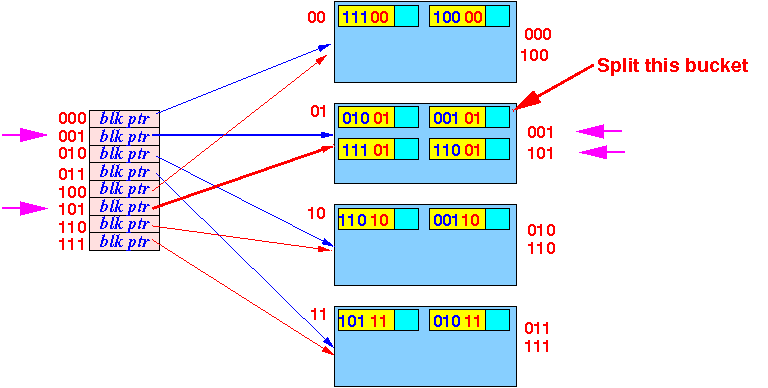
- We can split the
physical bucket 01
by:
- Re-hash
only the
key in the
physical bucket
using their last 3 bits:

-
Then
adjust the
logical ⇒ physical
hash bucket mapping:
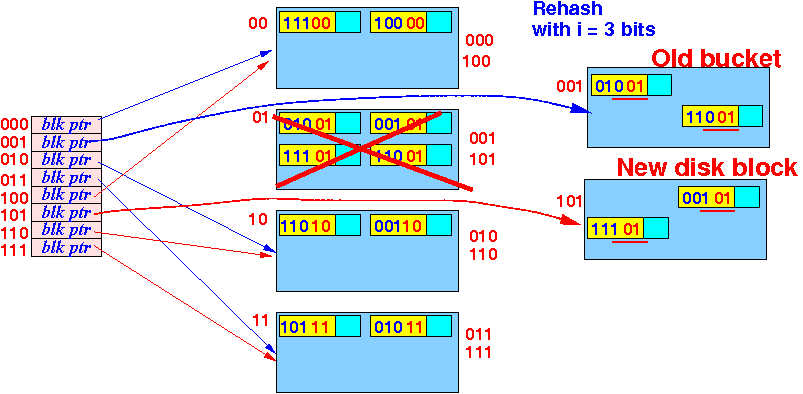
Final state:
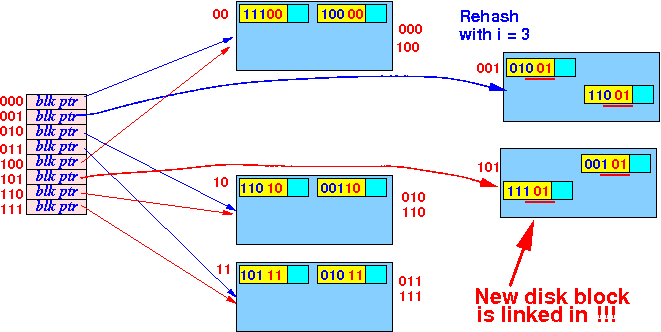
- Re-hash
only the
key in the
physical bucket
using their last 3 bits:
- Consider the
physical bucket 01
